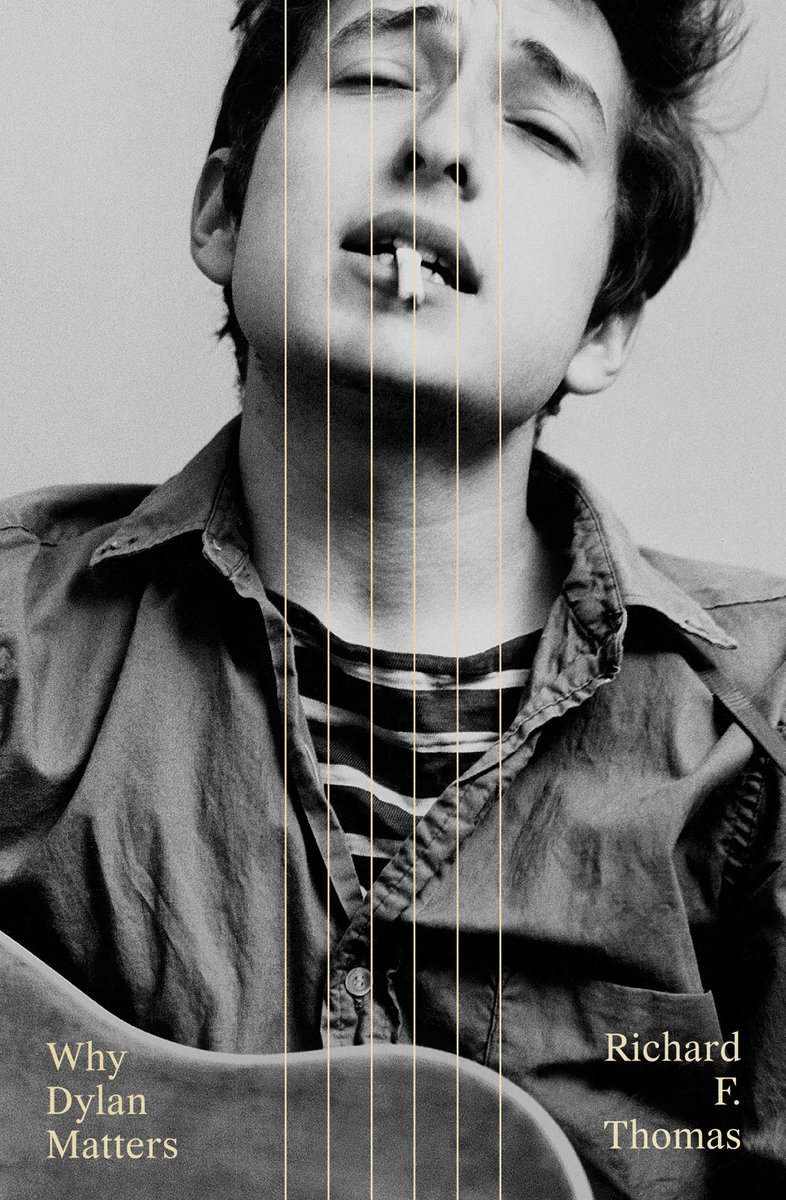Richard F Thomas: Why Dylan Matters review - tangled up in clues | reviews, news & interviews
Richard F Thomas: Why Dylan Matters review - tangled up in clues
Richard F Thomas: Why Dylan Matters review - tangled up in clues
Opening the door on Homer - why it's all Greek to Dylan

A year ago, Bob Dylan was awarded the Nobel Prize for Literature, his work commended by the committee "for having created new poetic expressions within the great American song tradition". The media response was like no other and we admirers felt vindicated.
Professor Christopher Ricks, long-time Dylan advocate whose vast output includes a fat tome on Dylan’s Visions of Sin, was among the cheerleaders. He has long compared Dylan to Milton, Tennyson and Eliot. When the news was announced, Richard F Thomas, Professor of Classics at Harvard, just across the Charles River from Ricks in Boston, was, coincidentally, heading off to teach his regular freshman seminar on Dylan. A teenager in New Zealand when Freewheelin’ was released, Thomas has now written a book – one that carries an endorsement from fellow-classicist Mary Beard, noting that he is the first classicist properly to turn his attention to Dylan.
For Thomas the singer-songwriter is “the supreme artist of the English language in my time” whose work “is literature, in an expansive rather than a limiting sense of the word”. But, “at the same time, Dylan’s award gives us reason to call into question the way we define ‘great literature' in modern society”. Robert Shelton, the New York Times critic whose 1961 review is credited with gaining Dylan his first record contract, long ago made the case for him as a poet, pointing out that Homer, too, was a busker.
Thomas rightly argues that the arts today are more vital than ever in what they can teach us and that “the art of Bob Dylan, no less than any other works produced by the human mind in its most creative manifestation, can be put to work serving and preserving the humanities”. His book makes a powerful case for doing so.
 Inevitably he’s a Dylan anorak (he notes that “Blowin’ in the Wind” has been sung live by Dylan 1,400 times since the 1971 Concert for Bangladesh, “Masters of War” 884 times by the close of 2016) but he writes engagingly, eschewing straightforward biography and focusing on key albums and songs which he subjects to intertextual analysis. From the vast acreage of newsprint, he offers quotes from interviews, particularly those by Mikal Gilmore, where Dylan has, often elliptically, thrown huge light on his work, offering signposts which have gone unremarked – even by clued-up interviewers.
Inevitably he’s a Dylan anorak (he notes that “Blowin’ in the Wind” has been sung live by Dylan 1,400 times since the 1971 Concert for Bangladesh, “Masters of War” 884 times by the close of 2016) but he writes engagingly, eschewing straightforward biography and focusing on key albums and songs which he subjects to intertextual analysis. From the vast acreage of newsprint, he offers quotes from interviews, particularly those by Mikal Gilmore, where Dylan has, often elliptically, thrown huge light on his work, offering signposts which have gone unremarked – even by clued-up interviewers.
In 2001 he told Gilmore that he was “talking to a person that feels like he’s working around in the ruins of Pompeii all the time. It’s always been that way”. Years before, “When I Paint My Masterpiece” was replete with Roman allusion, and Rome is a city to which Dylan has often travelled. At Hibbing High he opted for a Latin class and in his early days in Greenwich Village he lodged for a time with Ray Gooch and Chloe Kiel, whose library (according to his memoir Chronicles, on which Thomas lavishes praise) provided the young Dylan with much food for thought: Thucydides, Sophocles, Tacitus, Ovid, Machiavelli, Dante, Suetonius… In 1991, with the first Gulf War raging, he told an interviewer: “You read the history of Ancient Greece and when the Romans came in, and nothing will ever bother you about America again. You’ll see what America is.”
Thomas does a great job of assembling such fragments, his commentary providing a context for his textual analysis. In “Lonesome Day” from “Love and Theft” he hears “Virgil, greatest of the Roman poets, singing with the voice of Dylan” who, like Virgil in Book 6 of the Aeneid, wants to “spare the defeated” and “tame the proud”. He hears Virgil also in “the majestic sadness” of “Not Dark Yet” (Time Out of Mind), “among the most poetic of Dylan’s songs”.
But Thomas doesn’t just write about Dylan and the Classics. He looks also at the influence of Rimbaud (as have many other critics) and suggests that the poem that inspired “Chimes of Freedom” was “Poor People in Church", which echoes both Rimbaud’s style and sentiment. He tackles “transfiguration”, which he describes as “an intertextuality of characters in the song, as much as the straight texts themselves", writing at length about “Tryin’ to Get to Heaven” (also from Time Out of Mind) which has “at least ten intertexts which Dylan arranges and reworks to produce a song whose elements speak from their own original contexts, while at the same time becoming integral and vital parts of the new song”. Using the famous “little blue notebook” (now in Tulsa, where Dylan’s archive will sit alongside Woody Guthrie’s), Thomas shows the meticulous work which went in to Dylan’s greatest songs, not least “Tangled Up in Blue”.
Dylan’s art, contends Thomas, “transcends time, and the power of his songs appeals to young adults whose parents were not yet born when Dylan started putting his words and music together. Dylan is here to stay. He has become a classic.”
- Why Dylan Matters by Richard F Thomas (Collins, £12.99)
- More book reviews on theartsdesk
The future of Arts Journalism
You can stop theartsdesk.com closing!
We urgently need financing to survive. Our fundraising drive has thus far raised £49,000 but we need to reach £100,000 or we will be forced to close. Please contribute here: https://gofund.me/c3f6033d
And if you can forward this information to anyone who might assist, we’d be grateful.

Subscribe to theartsdesk.com
Thank you for continuing to read our work on theartsdesk.com. For unlimited access to every article in its entirety, including our archive of more than 15,000 pieces, we're asking for £5 per month or £40 per year. We feel it's a very good deal, and hope you do too.
To take a subscription now simply click here.
And if you're looking for that extra gift for a friend or family member, why not treat them to a theartsdesk.com gift subscription?
more Books
 'We are bowled over!' Thank you for your messages of love and support
Much-appreciated words of commendation from readers and the cultural community
'We are bowled over!' Thank you for your messages of love and support
Much-appreciated words of commendation from readers and the cultural community
 Thomas Pynchon - Shadow Ticket review - pulp diction
Thomas Pynchon's latest (and possibly last) book is fun - for a while
Thomas Pynchon - Shadow Ticket review - pulp diction
Thomas Pynchon's latest (and possibly last) book is fun - for a while
 Justin Lewis: Into the Groove review - fun and fact-filled trip through Eighties pop
Month by month journey through a decade gives insights into ordinary people’s lives
Justin Lewis: Into the Groove review - fun and fact-filled trip through Eighties pop
Month by month journey through a decade gives insights into ordinary people’s lives
 Joanna Pocock: Greyhound review - on the road again
A writer retraces her steps to furrow a deeper path through modern America
Joanna Pocock: Greyhound review - on the road again
A writer retraces her steps to furrow a deeper path through modern America
 Mark Hussey: Mrs Dalloway - Biography of a Novel review - echoes across crises
On the centenary of the work's publication an insightful book shows its prescience
Mark Hussey: Mrs Dalloway - Biography of a Novel review - echoes across crises
On the centenary of the work's publication an insightful book shows its prescience
 Frances Wilson: Electric Spark - The Enigma of Muriel Spark review - the matter of fact
Frances Wilson employs her full artistic power to keep pace with Spark’s fantastic and fugitive life
Frances Wilson: Electric Spark - The Enigma of Muriel Spark review - the matter of fact
Frances Wilson employs her full artistic power to keep pace with Spark’s fantastic and fugitive life
 Elizabeth Alker: Everything We Do is Music review - Prokofiev goes pop
A compelling journey into a surprising musical kinship
Elizabeth Alker: Everything We Do is Music review - Prokofiev goes pop
A compelling journey into a surprising musical kinship
 Natalia Ginzburg: The City and the House review - a dying art
Dick Davis renders this analogue love-letter in polyphonic English
Natalia Ginzburg: The City and the House review - a dying art
Dick Davis renders this analogue love-letter in polyphonic English
 Tom Raworth: Cancer review - truthfulness
A 'lost' book reconfirms Raworth’s legacy as one of the great lyric poets
Tom Raworth: Cancer review - truthfulness
A 'lost' book reconfirms Raworth’s legacy as one of the great lyric poets
 Ian Leslie: John and Paul - A Love Story in Songs review - help!
Ian Leslie loses himself in amateur psychology, and fatally misreads The Beatles
Ian Leslie: John and Paul - A Love Story in Songs review - help!
Ian Leslie loses himself in amateur psychology, and fatally misreads The Beatles
 Samuel Arbesman: The Magic of Code review - the spark ages
A wide-eyed take on our digital world can’t quite dispel the dangers
Samuel Arbesman: The Magic of Code review - the spark ages
A wide-eyed take on our digital world can’t quite dispel the dangers
 Zsuzsanna Gahse: Mountainish review - seeking refuge
Notes on danger and dialogue in the shadow of the Swiss Alps
Zsuzsanna Gahse: Mountainish review - seeking refuge
Notes on danger and dialogue in the shadow of the Swiss Alps

Add comment